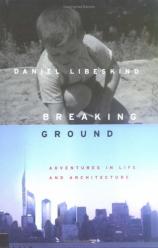Breaking Ground: Adventures in Life And Architecture
Review
Breaking Ground: Adventures in Life And Architecture
Daniel Libeskind is a successful, controversial, and influential
architect whose most famous commission is the World Trade Center
site. He was born in Poland in 1946, and his family immigrated to
Israel eleven years later. He once shared a Tel Aviv concert hall
with another child prodigy, Itzhak Perlman. Itzhak would, of
course, continue his musical education, but Daniel's field would
instead be art --- or so he thought. Two years later the Libeskind
family settled in New York. Daniel loved to draw and spent most of
his free time doing just that. His mother, a practical woman and a
Holocaust survivor, steered her son toward architecture. She felt
that he would not be able to support himself as an artist but could
not have known then that her advice would have such a huge impact
on her son's life.
A great deal of BREAKING GROUND describes Daniel's theories about
architecture: that buildings, like people, have a body and a soul,
that light is an extremely important element to consider when
designing a building, and that buildings truly reflect history. He
concentrates on what the building will feel like rather than what
it will look like. Unorthodox in his approach to the design process
itself, he readily admits to not quite understanding how he chooses
what to design.
When the book was being written in July of 2004 Daniel already had
three completed museum buildings to his credit as well as
thirty-five projects being worked on in Milan, San Francisco, Hong
Kong and London, among other cities.
After a fierce and lengthy competition Daniel's firm was chosen as
master planner for the World Trade Center site. Because of what
that famous parcel of land represents to so many people, a great
amount of public controversy occurred during the exhaustive
selection of architects and designs. Thousands of people gave their
opinions on what should be on that site as well as how the memorial
should look. It gave Daniel instant name recognition with the
general public who might otherwise never know of him.
When Daniel visited Ground Zero he insisted upon going down into
the vast crater, nicknamed "the bathtub," which is seventy feet
deep in some spots. There he encountered the slurry wall, a virtual
dam and foundation whose purpose was to keep the Hudson River at
bay. Though the devastation on 9/11 had been horrific, if the
slurry wall had been breached the subway system would have flooded
as well. The slurry wall and the pit spoke to Daniel. He
immediately decided that it must be visible and incorporated into
the design. He also insisted that Freedom Tower be 1,776 feet tall.
In New York, a huge city that lays things out in a grid pattern,
Daniel wanted a circle of buildings of various heights. That circle
itself was controversial.
No matter what one thinks of Daniel personally or professionally,
he has emerged as a brilliant architect, a visionary, and a
celebrity. It will be very interesting to see what the victims'
families, 9/11 survivors, New York City residents, and the rest of
the country think of Daniel's final interpretation at the World
Trade Center site.
Reviewed by Carole Turner on December 23, 2010
Breaking Ground: Adventures in Life And Architecture
- Publication Date: September 23, 2004
- Genres: Nonfiction
- Hardcover: 304 pages
- Publisher: Riverhead Hardcover
- ISBN-10: 1573222925
- ISBN-13: 9781573222921










